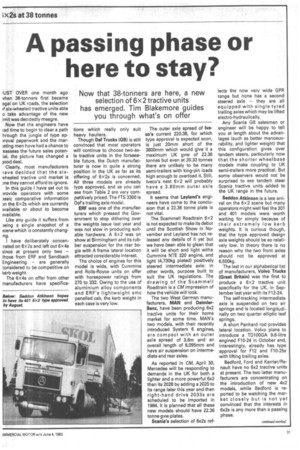A passing phase or here to stay?
Page 33

If you've noticed an error in this article please click here to report it so we can fix it.
Now that 38-tonners are here, a new selection of 6 x 2 tractive units has emerged. Tim Blakemore guides you through what's on offer
JUST OVER one month ago vhen 38-tonners first became agal on UK roads, the selection if six-wheeled tractive units able o take advantage of the new imit was decidedly meagre.
Now that the engineers have lad time to begin to clear a path hrough the jungle of type ap>royal paperwork and the mar:eting men have had a chance to eassess the future sales potenial, the picture has changed a jood deal.
Clearly, most manufacturers lave decided that the sixvheeled tractive unit market is )ne they cannot afford to ignore.
In this guide I have set out to )rovide operators with some )asic comparative information )fl the 6x 2s which are currently wailable or about to become Like any guide it suffers from )eing a single snapshot of a scene which is constantly chang
I have deliberately concen:rated on 6x2s and left out 6x 4s since at present only two — those from ERF and Sandbach Engineering — are generally onsidered to be competitive on kerb weight.
The 6x4s on offer from other manufacturers have specifica tions which really only suit heavy hauliers.
Though Daf Trucks (GB) is still convinced that most operators will continue to choose two-axle tractive units in the forseeable future, the Dutch manufacturer is now in quite a strong position in the UK as far as its offering of 6x2s is concerned. All three models are already type approved, and as you can see from Table 2 are very competitively priced. The FTS 3300 is Daf's trailing axle model.
ERF was one of the manufacturers which pressed the Government to stop dithering over the weights issue last year and was not slow in producing suitable hardware. A 6x2 was on show at Birmingham and its rubber suspension for the rear bogie with A frame lateral location attracted considerable interest.
The choice of engines for this model is wide, with Cummins and Rolls-Royce units on offer with horsepower ratings from 270 to 332. Owing to the use of aluminium alloy components and ERF's lightweight smc panelled cab, the kerb weight in each case is very low.
The outer axle spread of lyeco's current 220.38, for which type approval is expected soon, is just 20mm short of the 3800mm which would give it a maximum UK gvw of 22.36 tonnes but even at 20.33 tonnes there are unlikely to be many semi-trailers with king-pin loads high enough to overload it. Still, Iveco's next 6x2 will probably have a 3.80mm outer axle spread.
It seems that Leyland's engineers have come to the conclusion that a 22.36 tonne plate is riot vital.
The Scammell Roadtrain 6x2 is not expected to make its debut until the Scottish Show in November and Leyland has not released any details of it yet but we have been able to glean that it will be short and light witha Cummins NTE 320 engine, and light (4,730kg plated) positively steered intermediate axle: in other words, purpose built to suit the UK regulations. The drawing of the Scammell Roadtrain is a CM impression of how the vehicle will look.
The two West German manufacturers, MAN and DaimlerBenz, have been producing 6x2 tractive units for their home market for some time. MAN's two models, with their recently introduced System 6 engines, are compact with an outer axle spread of 3.6m and an overall length of 6,095mm and have air suspension on intermediate and rear axles.
As reported in CM, April 30, Mercedes will be responding to demands in the UK for both a lighter and a more powerful 6x2 than its 2028 by adding a 2025 to its range later this year and then right-hand drive 2033s are scheduled to be imported in 1984. It is planned that all these new models should have 22.36 tonne gvw plates.
Scania's selection of 6x2s ref lects the now very wide GPR range but none has a second steered axle — they are all equipped with single tyred trailing axles which may be lifted electro-hydraulically.
Any Scania GB salesman or engineer will be happy to tell you at length about the advantages (such as better manoeuvrability, and lighter weight) that this configuration gives over tandem steers, particularly now that the shorter wheelbase models make coupling to UK semi-trailers more practical. But some observers would not be surprised to see tandem steer Scania tractive units added to the UK range in the future.
Seddon Atkinson is a late arrival on the 6x2 scene but many operators might well feel the 301 and 401 models were worth waiting for simply because of their extremely low kerb weights. It is curious though, that the type approved design axle weights should be so relatively low. In theory there is no reason why the two front axles should not be approved at 6,500kg.
The last in our alphabetical list of manufacturers, Volvo Trucks
(Great Britain) was the first to produce a 6x2 tractive unit specifically for the UK, in September last year with its F12-24.
The self-tracking intermediate axle is suspended on two air springs and is located longitudinally on two quarter elliptic leaf springs.
A short Panhard rod provides lateral location. Volvo plans to introduce a TD100GA 9.6-litre engined F10-24 in October and, interestingly, already has type approval for F12 and F10-25s with lifting trailing axles.
Bedford, Ford and Karrier/Renault have no 6x2 tractive units at present. The two latter manu facturers are concentrating on the introduction of new 4x2 models, while Bedford is re ported to be watching the market closely but is not yet convinced that the interests in 6x2s is any more than a passing phase.
































































































